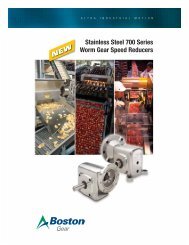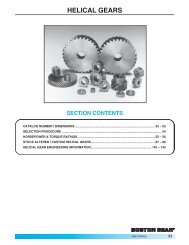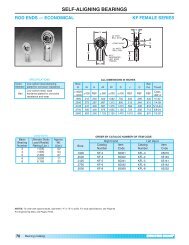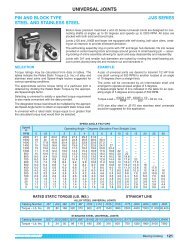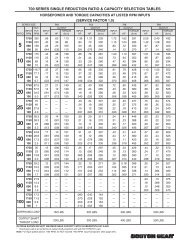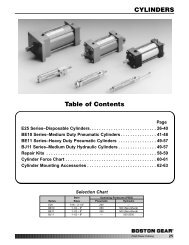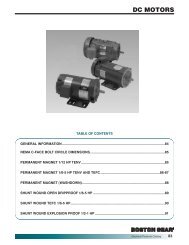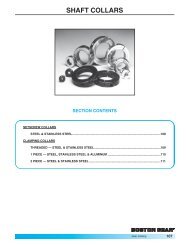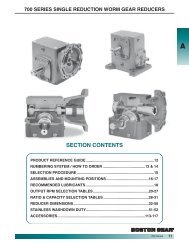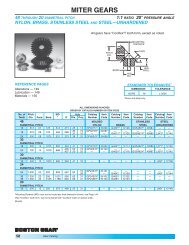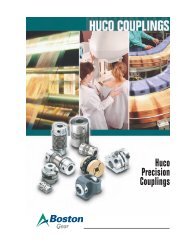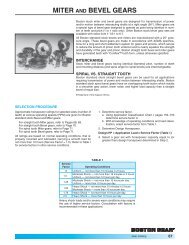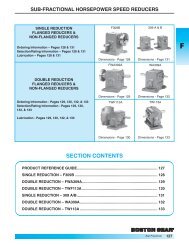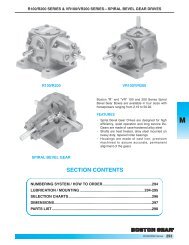Modified Stock Gearing - Boston Gear
Modified Stock Gearing - Boston Gear
Modified Stock Gearing - Boston Gear
Create successful ePaper yourself
Turn your PDF publications into a flip-book with our unique Google optimized e-Paper software.
Engineering Information<br />
General<br />
I<br />
Mounting<br />
SPUR & HELICAL<br />
For proper functioning gears, gears must be accurately<br />
aligned and supported by a shaft and bearing system which<br />
maintains alignment under load. Deflection should not exceed<br />
.001 inch at the tooth mesh for general applications. The<br />
tolerance on Center Distance normally should be positive to<br />
avoid possibility of gear teeth binding. Tolerance value is<br />
dependent on acceptable system backlash. As a guide for<br />
average application, this tolerance might vary from .002 for<br />
<strong>Boston</strong> <strong>Gear</strong>’s fine pitch gears to .005 for the coarsest pitch.<br />
WORMS AND WORM GEAR<br />
It is important that the mounting assures the central plane of<br />
the Worm gear passes essentially through the axis of the<br />
Worm. This can be accomplished by adjusting the Worm<br />
<strong>Gear</strong> axially. <strong>Boston</strong> Worm <strong>Gear</strong>s are cut to close tolerancing<br />
of the Center Line of the <strong>Gear</strong> tooth to the flush side of the<br />
<strong>Gear</strong>. When properly mounted Worm <strong>Gear</strong>s will become more<br />
efficient after initial break-in period.<br />
HOW WORM GEARS “ADJUST” THEMSELVES<br />
The gear in a worm gear reducer is made of a soft bronze<br />
material. Therefore, it can cold-work and wear-in to<br />
accommodate slight errors in misalignment.<br />
Evolution of Contact in a Worm <strong>Gear</strong><br />
Entering<br />
side<br />
Worm<br />
rotation<br />
Leaving<br />
side<br />
Initially, contact is<br />
concentrated on the leaving<br />
side of the worm.<br />
After several hours or<br />
running under load, gear<br />
has cold-worked to spread<br />
area of contact.<br />
Alterations<br />
<strong>Boston</strong> <strong>Gear</strong> Service Centers are equipped to alter catalog<br />
sprockets (rebore, keyway, setscrew, etc.). For customers,<br />
choosing to make their own alterations, the guidelines listed<br />
below should be beneficial. Alterations to hardened gears<br />
should not be made without consultation with factory.<br />
In setting up for reboring the most important consideration is<br />
to preserve the accuracy of concentricity and lateral runout<br />
provided in the original product. There are several methods<br />
for accomplishing this. One procedure is: mount the part on<br />
an arbor, machine hub diameter to provide a true running<br />
surface, remove from arbor and chuck on the hub diameter,<br />
check face and bore runout prior to reboring. As a basic rule<br />
of thumb, the maximum bore should not exceed 60% of the<br />
Hub Diameter and depending on Key size should be checked<br />
for minimum wall thickness. A minimum of one setscrew<br />
diameter over a keyway is considered adequate.<br />
<strong>Boston</strong> <strong>Gear</strong> offers a service for hardening stock sprockets.<br />
This added treatment can provide increased horsepower<br />
capacity with resultant longer life and/or reduction in size and<br />
weight.<br />
Customers wishing to do the hardening operation should<br />
refer to “Materials” below for information.<br />
Lubrication<br />
The use of a straight mineral oil is recommended for most<br />
worm gear applications. This type of oil is applicable to gears<br />
of all materials, including non-metallic materials.<br />
Mild E.P. (Extreme Pressure) lubricants may be used with Iron<br />
and Steel <strong>Gear</strong>s. E.P. lubricants normally should be selected<br />
of the same viscosity as straight mineral oil, E.P. lubricants<br />
are not recommended for use with brass or bronze gears.<br />
SAE80 or 90 gear oil should be satisfactory for splash<br />
lubricated gears. Where extremely high or low speed<br />
conditions are encountered, consult a lubricant manufacturer.<br />
Oil temperature of 150°F should not be exceeded for<br />
continuous duty applications. Temperatures up to 200°F can<br />
be safely tolerated for short periods of time.<br />
Many specialty lubricants have been recently developed to<br />
meet the application demands of today’s markets, including<br />
synthetics and both high and low temperature oils and<br />
greases. In those instances where Bath or Drip Feed is not<br />
practical, a moly-Disulphide grease may be used<br />
successfully, for low speed applications.<br />
After many hours of<br />
operation, contact has<br />
spread to cover the entire<br />
working area of the tooth.<br />
314 <strong>Boston</strong> <strong>Gear</strong> 800-825-6544 P-1930-BG 04/10



